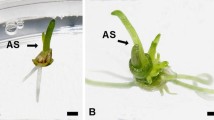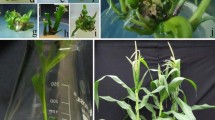Abstract
Electrophoretic patterns for isocitrate dehydrogenase (IDH; EC 1.1.1.42), acid phosphatase (ACP; EC 3.1.3.2), peroxidase (PER; EC 1.11.1.7), and esterase (EST; EC 3.1.1.1) isozymes were determined inCereus peruvianus tissues and used as markers of genetic uniformity of calli and of the plants regenerated from callus cultures. One IDH, six ACP, six PER, and six EST isozymes were induced in cultured callus tissues in medium containing three 2,4-dichlorophenoxyacetic acid and kinetin combinations. Four ACP, two PER, and three EST isozymes were still present in all regenerated plantsin vitro and therefore can be used as markers of theC. peruvianus plants regenerated from callus tissues. The differential patterns of ACP and IDH isozymes and the similar zymograms for PER and EST isozymes presented by callus tissues were used in a comparison of callus tissues cultured for 2 years. The comparative analysis of zymograms within each enzyme system indicated a mean heterogeneity coefficient of 0.33 forC. peruvianus calli cultured for 2 years. Because of the isozyme variations, which developed in culture medium and were transferred to the regenerated plants, the IDH, ACP, PER, and EST enzyme systems can be considered to be good markers for investigating possible genetic variations in plant populations ofC. peruvianus obtainedin vitro from callus culture.
Similar content being viewed by others
References
Alvarez, M., Costa, S. C., Utumi, H., Huber, A., Beck, R., and Fontana, J. D. (1992). The anionic glycan from the cactusCereus peruvianus.Appl. Biochem. Biotechnol. 34/35283.
Chawla, H. S. (1988). Isozyme modifications during morphogenesis of callus from barley and wheat.Plant Cell Tissue Organ Cult. 12299.
D'Amato, F. (1980). In Sala, F., Pasiri, B., Cella, R., and Cifferri, O. (eds.)Plant Cell Cultures: Results and Perspectives Elsevier, Holland, pp. 287–296.
Doods, J. H. (1991). Introduction: Conservation of plant genetic resource—The need for tissue culture. In Doods, J. H. (ed.),In Vitro Methods for Conservation of Plant Genetics Resource Chapman and Hall, London, pp. 1–9.
Duff, S. M., Plaxton, W. C., and Lefebvre, D. D. (1991). Phosphate-startion response in plant cells: De novo synthesis and degradation of acid phosphatases.Proc. Natl. Acad. Sci. 889538.
Everett, N. P., Wach, M. J., and Ashworth, D. J. (1985). biochemical markers of embryogenesis in tissue cultures of the maize inbreed B73.Plant Sci. 41133.
Ferguson, A. (1980).Biochemical Systematic and Evolution Blakie, Glasgow and London.
Fransz, P. F., de Ruijter, N. C. A., and Schel, J. H. N. (1989). Isozymes as biochemical and cytochemical markers in embryogenic callus cultures of maize (Zea mays L.).Plant Cell Rep. 867.
Hussey, G. (1986). Vegetative propagation of plants by tissue culture. In Yeoman, M. M. (ed.),Plant Cell Culture Technology, Vol. 23 Blackwell Scientific, Oxford, pp. 7–25.
Karp, A., and Bright, S. W. J. (1985). On the causes and origins of somaclonal variation. InOxford Surveys of Plant Molecular and Cell Biology, Vol. 2 Oxford University Press, Oxford, pp. 199–243.
Larkin, P., and Scowcroft, W. R. (1981). Somaclonal variation—A novel source of variability from cell cultures for plant improvement.Theor. Appl. Genet. 60197.
Lee, T. T. (1972a). Changes in indolacetic acid oxidase isozymes in tobacco tissues after treatments with 2,4-dichlorophenoxiacetic acid.Plant Physiol. 49957.
Lee, T. T. (1972b). Interaction of cytokinin, auxin, and gibberellin on peroxidase isozyme in tobacco tissues culturedin vitro.Can. J. Bot. 502471.
Machado, M. F. P. S., Prioli, A. J., and Mangolin, C. A. (1993). Malate dehydrogenase (MDH; EC 1.1.1.37) isozymes in tissue and callus cultures ofCereus peruvianus (Cactaceae).Biochem. Genet. 31167.
McClure, J. W. (1979). The physiology of phenolic compounds in plants. In Stain, T. (ed.),Biochemistry of Plant Phenolics Plenum Press, New York and London, pp. 527–556.
Meins, F., Jr. (1986). Determination and morphogenetic competence in plant tissue culture. In Yeoman, M. M. (ed.),Plant Cell Culture Technology, Vol 23 Blackwell Scientific, Oxford, pp. 7–25.
Nehra, N. S., Kartha, K. K., and Stushnoff, C. (1991). Isozymes as markers for identification of tissue culture and green-house-grown strawberry cultivars.Can. J. Plant Sci. 711195.
Oliveira, S. A. (1993).Cultura de tecidos e regeneraçāo de plantas de Cereus peruvianus, Ms. thesis, State University of Maringa, Paraná, Brazil.
Olson, A. C., Evans, J. J., Frederick, D. P., and Jansen, E. F. (1969). Plant suspension culture media, macromolecules, pectic substances, protein and peroxidase.Plant Physiol. 441594.
Potter, R. H., and Jones, M. G. K. (1991). Molecular analysis of genetic stability. In Doods, J. H. (ed.), In VitroMethods for Conservation of Plant Genetic Resources, Chapman and Hall, London, pp. 71–91.
Ricard, J., Teissere, M., Azou, Y., and Penon, P. (1976). Hormonal control of ribonucleic acid and protein synthesis in plants.J. Microsc. Biol. Cell 26139.
Scandalios, J. G., and Sorensen, J. C. (1977). In Reinert, J., and Bajay, Y. P. S. (eds.),Applied and Fundamental Aspects of Plant Cell, Tissue and Organ Culture Springer Verlag, Berlin, pp. 719–730.
Stebbins, G. L. (1989). Introduction. In Soltis, D. E., and Soltis, P. S. (eds.),Isozymes in Plant Biology, Advances in Plant Science Series, Vol.4 Dioscorides Press, Portland, OR, pp. 1–4.
Withers, L. A. (1980).Tissue Culture Storage for Genetic Conservation IBPGR Technical Document, Rome.
Wochok, Z. S., and Burleson, B. (1974). Isoperoxidase activity and induction in cultured tissues of wild carrot: A comparison of proembryos and embryos.Physiol. Plant. 3173.
Author information
Authors and Affiliations
Additional information
This research was supported by the CNPq
Rights and permissions
About this article
Cite this article
Mangolin, C.A., Prioli, A.J. & Machado, M.F.P.S. Isozyme patterns in callus cultures and in plants regenerated from calli ofCereus peruvianus (Cactaceae). Biochem Genet 32, 237–247 (1994). https://doi.org/10.1007/BF00555827
Revised:
Issue Date:
DOI: https://doi.org/10.1007/BF00555827




